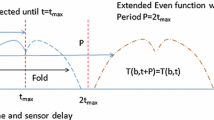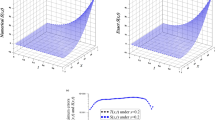Abstract
This paper describes some recent observations associated with (1) clarifying and expanding upon the integral relationship between temperature and heat flux in a half-space; (2) offering an analytic-continuation approach for estimating the surface temperature and heat flux in a one-dimensional geometry based on embedded measurements; and, (3) offering a novel digital filter that supports the use of analytic continuation based on a minimal number of embedded sensors. Key to future inverse analysis must be the proper understanding and generation of rate data associated with both the temperature and heat flux at the embedded location. For this paper, some results are presented that are theoretrically motivated but presently adapted to implement digital filtering. A pulsed surface heat flux is reconstructed by way of a single thermocouple sensor located at a well-defined embedded location in a half space. The proposed low-pass, Gaussian digital filter requires the specification of a cut-off frequency that is obtained by viewing the power spectra of the temperature signal as generated by the Discrete Fourier Transform (DFT). With this in hand, and through the use of an integral relationship between the local temperature and heat flux at the embedded location, the embedded heat flux can be accurately estimated. The time derivatives of the filtered temperature and heat flux are approximated by a simple finite-difference method to provide a sufficient number of terms required by the Taylor series for estimating (i.e., the projection) the surface temperature and heat flux. A numerical example demonstrates the accuracy of the proposed scheme. A series of appendices are offered that describe the mathematical details omitted in the body for ease of reading. These appendices contain important and subtle details germane to future studies.
Similar content being viewed by others
References
Doebelin EO (1975) Measurement systems. McGraw-Hill, New York
Diller TE (1993) Advances in heat flux measurements. Vol. 23. Academic Press, New York, pp 279–368
Keltner NR (1997) Heat flux measurements: theory and applications. In: Keltner NR (ed) Thermal measurements in electronic cooling. CRC, New York, pp 273–320
Holman JP (1984) Experimental methods for engineers, 4th ed. McGraw Hill, New York
Kress R (1989) Linear integral equations. Springer-Verlag, Berlin
Wing GM (1991) A primer on integral equations of the first kind. SIAM, Philadelphia
Beck JV, Blackwell B, St. Clair CR, Jr (1985) Inverse heat conduction. Wiley, New York
Kurpisz K, Nowak AJ (1995) Inverse thermal problems. Computational Mechanics, Southampton
Linz P (1985) Analytical and numerical methods for Volterra equations. SIAM, Philadelphia
Baker CTH (1978) The numerical treatment of integral equations. Clarendon Press, Oxford
Frankel JI, Keyhani M, Taira K (2004) In-phase error estimation of experimental data and optimal first derivatives. AIAA J 42: 1017–1024
Frankel JI, Keyhani M (1999) Inverse heat conduction: The need of \(\partial T \over \partial t\) data for design and diagnostic purposes. In: IASTED MIC 99, Innsbruck, Austria
Frankel JI (2000) Inverse heat conduction and data-type issues. Boun Elem Commun 11:37–42
Frankel JI, Osborne GE, Taira K (2006) Stabilization of ill-posed problems through thermal rate sensors. AIAA J Thermophys Heat Trans 20:238–246
Frankel JI, Lawless JJ (2005) Numerically stabilizing ill-posed moving surface problems through heat rate sensors. AIAA J Thermophys Heat Trans 19:587–592
Frankel JI, Osborne GE (2004) Motivation for the development of heating/cooling rate dT/dt and heat flux rate dq′′/dt sensors for engineering applications. In: 42nd AIAA Aerospace sciences meeting and exhibit, Reno, NV, January 5–8.
Frankel JI (2005) Heating/cooling rate sensor development for stable, real-time heat flux predictions. 43rd AIAA Aerospace sciences meeting and exhibit, Reno, NV, January 10–13
Ozisik MN (1980) Heat conduction. Wiley, New York
Frankel JI, Vick B, Ozisik MN (1985) Flux formulation in hyperbolic heat conduction. J Appl Phys 58:3340–3345
Frankel JI (1991) Nonlinear heat transfer: solution of singular, nonlinear integral equations. Eng Anal 8:231–238
Hildebrand FB (1976) Advanced calculus for applications, 2nd ed. Prentice Hall, Englewood Cliffs
Hanke M, Scherzer O (2001) Inverse problems light: numerical differentiation. Amer Math Monthly 108:512–520
Groetsch T (1991) Differentiation of approximately specified functions. Amer Math Monthly 98:847–850
Frankel JI, Arimilli RV (in press) Inferring convective and radiative heating loads from transient surface temperature measurements in the half-space. Inverse Prob Sci Eng
Stakgold I (1979) Green’s functions and boundary value problems. Wiley, New York
Kulish VV, Novozhilov VB (2003) Integral equation for the heat transfer with the moving boundary. AIAA J Thermophys Heat Trans 17:538–540
Kulish VV, Lage JL (2000) Fractional diffusion solutions for transient local temperature and heat flux. Heat Trans 122:372–376
Frankel JI (2006) Generalizing the method of Kulish to one-dimensional unsteady heat conducting slabs. J Thermophys Heat Trans 20:945–950
Briggs WL, Henson VE (1995) The DFT. SIAM, Philadelphia
Press WH, Flannery BP, Teukolsky SA, Vetterling WT (1986) Numerical recipes. Cambridge University Press, Cambridge
Hamming RW (1989) Digital filters, 3rd ed. Dover, New York
Frankel JI, Arimilli RV, Keyhani M, Wu J (2006) Heating rate dT/dt measurements developed from in-situ thermocouples using a voltage-rate interface for advanced thermal diagnostics. In: 25th AIAA Aerodynamics measurement technology ground testing conference, San Francisco, June 5–8
Brebbia CA, Telles JCF, Wrobel LC (1984) Boundary element techniques. Springer-Verlag, New York
Greenberg MD (1971) Applications of Green’s functions in science and engineering. Prentice-Hall, Englewood Cliffs
Kythe PK, Puri P (2002) Computational methods for linear integral equations. Birkhauser, Boston
Martin PA (1992) Exact solution of a simple hypersingular integral equation. J Int Equ Applic 4:197–204
Kaya AC, Erdogan F (1987) On the solution of integral equations with strongly singular kernels. Q Appl Math 45:105–122
Monegato G (1994) Numerical evaluation of hypersingular integrals. J Comp Appl Math 50:9–31
Cook WJ, Felderman EJ (1966) Reduction of data from thin-film heat transfer gages: a concise numerical technique. AIAA J 4:561–562
Author information
Authors and Affiliations
Corresponding author
Rights and permissions
About this article
Cite this article
Frankel, J.I. Regularization of inverse heat conduction by combination of rate sensor analysis and analytic continuation. J Eng Math 57, 181–198 (2007). https://doi.org/10.1007/s10665-006-9073-y
Received:
Accepted:
Published:
Issue Date:
DOI: https://doi.org/10.1007/s10665-006-9073-y




